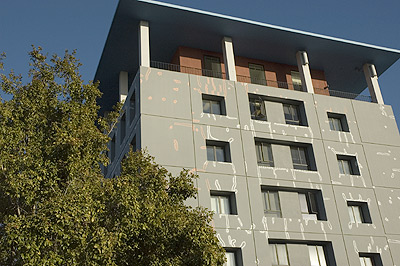Berkeleyan
 |
The mysterious markings on the outside of Barrows Hall note cosmetic defects related to the building's seismic upgrade several years ago; the defects will be repaired during the summer. (Wendy Edelstein photo) |
What are they building over there?
Construction and landscaping updates from Capital Projects and Physical Plant - Campus Services
![]()
| 17 January 2007
Construction seems as much a part of the landscape here at Berkeley as Oski or the Campanile. To explain the hieroglyphics on Barrows Hall and unravel other mysteries of the local landscape, we've compiled information on current campus construction and landscaping projects.
Building news
Early this semester, a huge bronze grille that will cover a significant portion of the building's southern fašade will be affixed to the C.V. Starr East Asian Library, under construction on the north side of Memorial Glade. The screen, which was cast in China, is being shipped to Berkeley. Earlier in the construction, crews cast large hooks in the building's concrete that will support the decorative piece. The Starr Library is on schedule for completion by the beginning of the fall semester, with its grand opening slated for October.
Stanley Hall, the Berkeley home of the California Institute for Quantitative Biomedical Research (QB3), will also be the site of a formal dedication next fall. Final work on the building's life safety and mechanical systems and landscaping is nearly complete. QB3 administrative offices are expected to move into the building in March. Then, over the next several months, three dozen faculty members from across campus — bioengineers, biologists, chemists, physicists — will relocate their offices and laboratories into the facility, as will the Department of Bioengineering.
Work on the new Davis Hall North building, future headquarters for the Center for Information Technology Research in the Interest of Society (CITRIS), is progressing. By mid-January, crews are scheduled to begin to build the structure's steel skeleton. To monitor the site's progress, visit the project webcam at www.citris-uc.org/capital_projects/webcam.
Barrows Hall is a work-in-progress of a different sort. While the markings on its west and east ends might appear purely artistic, they delineate areas of concrete that need repair due to product defects. The exterior "bookends" that were added several years ago as part of the building's seismic upgrade have cosmetic defects - small voids beneath the painted surface that over time could lead to visible deterioration of the finish and, possibly, hazardous pieces of falling concrete.
To repair the defective concrete finish, Capital Projects two weeks ago tested a method of removing the painted surface that involves use of an air compressor and vacuum equipment. The project team tested the noise this method would create and assessed how long it would take, information important to those charged with planning the necessary repairs while causing the least amount of disruption. The project is currently scheduled for summer 2007. The need for this repair to the concrete surfaces does not compromise the structure; Barrows Hall remains seismically safe, with a seismic rating of "good."
Work on the ground level
New walkways, grass, and granite benches have cropped up southwest of North Gate Hall, thanks to funding from the Class of '54. The granite benches are former windowsills from the Hearst Memorial Mining Building, removed during that structure's retrofit and renovation in the late 1990s. Campus landscape architect Jim Horner, who rescued the granite, came up with the idea of repurposing the material rather than leaving it to languish in storage.
Improved curb cuts and parking spaces have been provided in front of Moses Hall - a ground-level undertaking that might escape most people's notice but will increase ease of navigation for members of the campus community with disabilities. The parking spaces are now connected to a path and entrance to Wheeler Hall that have also been improved for use by those with mobility limitations. Numerous small but important improvements like these are being made as the campus has committed to removing physical barriers to the disabled.
Last spring's rain saturated the Bay Area, including the ground beneath Centennial Drive, causing damage to the pavement and foundation. The main repair work on that well-traveled artery is nearly complete. Tom Klatt, director of emergency planning and communications, is collaborating with Capital Projects and Physical Plant - Campus Services to add culverts and improve stormwater flow in the campus hill area to prevent similar problems in the future.
Bits and pieces
In other construction news, concrete is being poured regularly at the new Underhill parking structure behind the Residential and Student Services Building at College Avenue and Channing Way. The dining commons for the Unit 3 residence halls reopens this week, with new noodle and sushi bars and improved interiors.
In early December the campus took ownership of the State Department of Health Building, bordered by Shattuck Avenue, Berkeley Way, and Hearst and Oxford streets, and is currently working to secure the building and plan for the future of the space. Campus parking will remain available in the adjacent lot for the foreseeable future.
For information about these and other campus projects, contact Christine Shaff, Facilities Services communications manager, at cshaff@berkeley.edu or 643-4793. More detail and updates on some of these projects can be found at www.cp.berkeley.edu.

